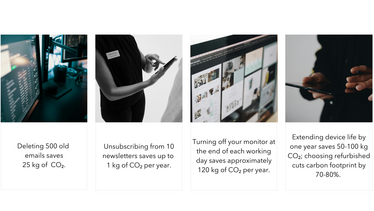
In an increasingly digitalized world, where software-related CO₂ emissions account for approximately 4-5% of global emissions, according to the Green Software Foundation – the responsible use of resources and energy consumption is becoming more and more important. IT is a prime example of how cross-departmental collaboration with the ESG team can achieve concrete results: Close communication leads to effective measures that reduce resource consumption and drive sustainable change.
Sustainable information technology is no longer an abstract idea at the DOUGLAS Group. The aim is to sustainably reduce the environmental impact of IT products and services, both in day-to-day operations and in strategic planning. On the path to more sustainable business activities, the relevant teams are supported by dialogue with the ESG department in order to achieve sustainable goals in line with corporate guidelines. This starts with the little things: the conscious use of e-mails or the avoidance of unnecessary computing processes. At the same time, the teams are systematically pushing ahead with larger projects such as the standardization of the internal DOUGLAS application landscape.
“For us, sustainability in IT is a holistic approach that runs through all levels,” explains Suhaim Mohamed, Head of Architecture & Application Portfolio Management IT at the DOUGLAS Group. “It starts with an inner attitude – that is, a conscious decision to think differently – and extends to the concrete implementation of technical measures.”
Promoting awareness, changing culture
Sustainable change can only succeed if it is supported by the people who shape it. That is why the DOUGLAS Group focuses on targeted training, workshops, and exchange formats within IT. In addition to a basic introduction to the topic of “Green IT,” a deep-dive training course tailored specifically to developers was developed.
“It was clear to us from the outset that a single training session would not be enough,” says Suhaim. “That's why we created a format that goes beyond mere knowledge transfer – with the aim of changing mindsets.” The focus is on the question: How can each colleague integrate sustainability aspects directly into their own work? Whether in the development of apps or the selection of technical solutions, this culture-oriented approach helps ensure that sustainability is not seen as an additional task, but as an integral part of everyday IT work.
To support this mindset shift, it’s often the small, concrete actions that make the biggest difference in day-to-day work. The following examples show just how much CO₂ can be saved through simple, conscious decisions – proving that sustainability starts with the details:

Less is more: technology consolidation with impact
A key goal of our IT strategy is to increase efficiency through technological consolidation – both in our infrastructure and in our application landscape. In a group-wide project, existing applications in the countries were reviewed to reduce their number in a targeted manner. After all, the more requirements are covered by a uniform solution, the lower the energy consumption – and thus also our CO₂ footprint.
Green coding also means less is more. The aim is to develop software in such a way that it runs as resource-efficiently as possible. “If a code is written inefficiently, more computing power has to be used, which consumes an unnecessary amount of energy,” explains Carsten Göldner, who is responsible for the guidelines and governance around IT. Intelligent caching, reduced data queries, and lean algorithms significantly reduce energy consumption and server load, with a positive effect on the environment, performance, and operating costs.
Sustainable success through cross-functional collaboration
The example of IT clearly shows that when departments and ESG teams work closely together, concrete, effective changes happen. This exchange makes sure that sustainable change isn't just wanted, but actually happens—for example, through more resource-efficient technologies and processes.
“More sustainable IT is becoming increasingly important. Technology permeates all our business processes – which is why it is essential that we also take responsibility here,” explains Ricarda Gallas, ESG Manager at the DOUGLAS Group. “Through the conscious and efficient use of IT resources, we can measurably reduce our ecological footprint.”
To meet this requirement, the ESG team works across departments, for example with IT, purchasing, and other specialist areas. The aim is to jointly identify specific levers that reduce emissions and conserve resources – whether through energy-efficient technologies, sustainable supply chains, optimized processes, or targeted training that strengthens a shared awareness of sustainability.


